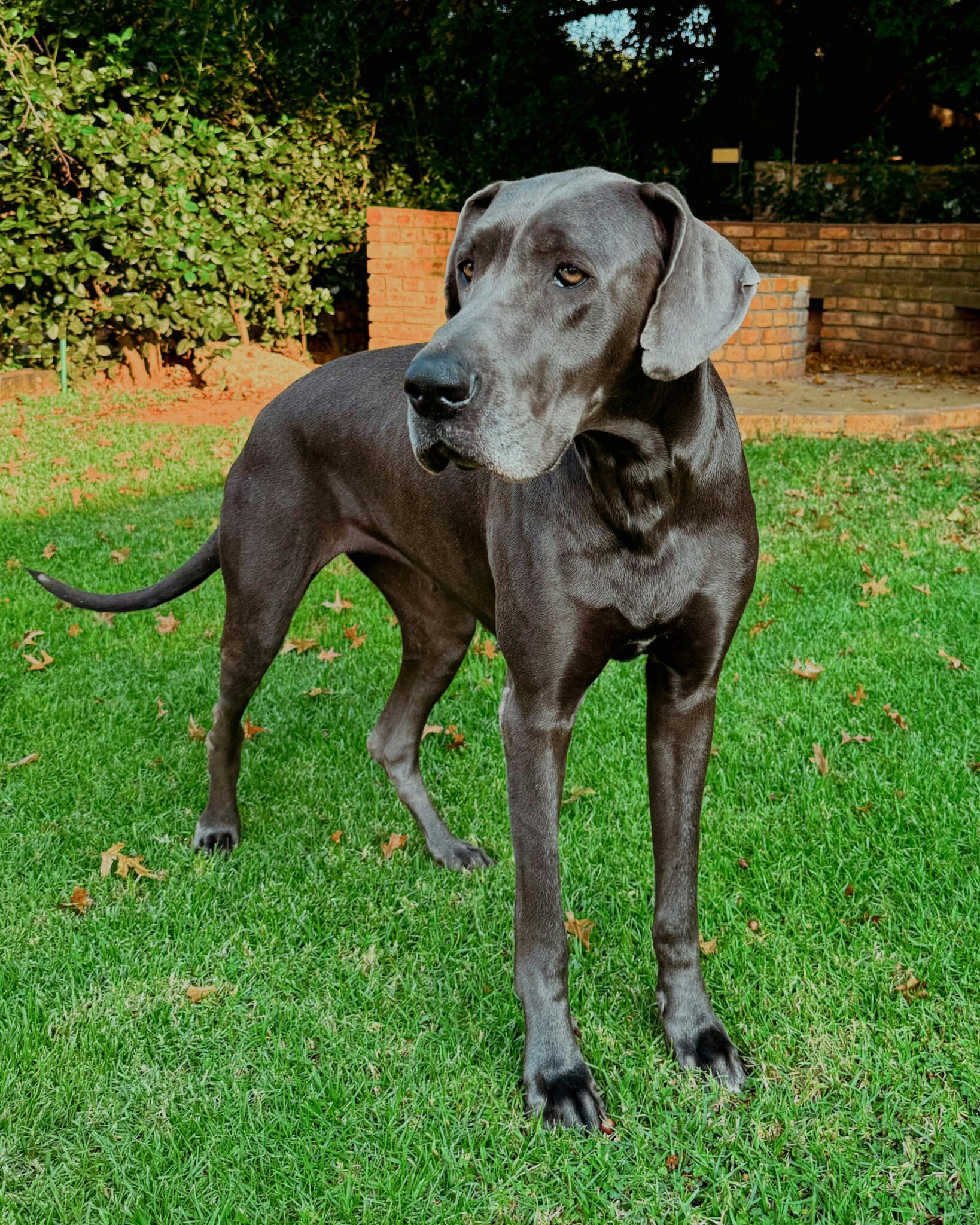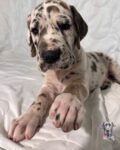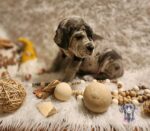
About the Breed
The easygoing Great Dane, the mighty “Apollo of Dogs,” is a total joy to live with, but owning a dog of such imposing size, weight, and strength is a commitment not to be entered into lightly. This breed is indeed great, but not a Dane.
As tall as 32 inches at the shoulder, Danes tower over most other dogs and when standing on their hind legs, they are taller than most people. These powerful giants are the picture of elegance and balance, with the smooth and easy stride of born noblemen. The coat comes in different colors and patterns, perhaps the best-known being the black-and-white patchwork pattern known as “harlequin.” Despite their sweet nature, Danes are alert home guardians. Just the sight of these gentle giants is usually enough to make intruders think twice. But those foolish enough to mistake the breed’s friendliness for softness will meet a powerful foe of true courage and spirit. Patient with kids, Danes are people pleasers who make friends easily
- Height 30-32 inches (male) 28-30 inches (female)
- 140-175 pounds (male) 110-140 pounds (female)
- LIFE EXPECTANCY 7-10 Years
”Owning a dog is not just a privilege; it’s a responsibility. They depend on us for, at minimum, food and shelter, and deserve much more. When you take a dog into your life, you need to understand the commitment that dog ownership entails”.
What To Expect When Caring For a Great Dane & Traits
Bloat, or gastric dilatation-volvulus (GDV), is the number-one killer of Danes. Owners should educate themselves to recognize the signs that bloat could be happening and what to do if so. Many breeders and owners consider a surgery called a prophylactic gastropexy (‘preventative tack’) that can help prevent some of the more serious aspects of GDV. Other health issues that can affect the breed include eye and cardiac diseases, hypothyroidism and autoimmune thyroiditis, and hip dysplasia. A responsible breeder will screenbreeding stock for conditions that can affect the breed.
Recommended Health Tests From the National Breed Club:
- Hip Evaluation
- Cardiac Exam
- Ophthalmologist Evaluation
- Thyroid Evaluation
For most of the year the Great Dane’s short, smooth coat doesn’t shed much, but given the size of the dog, this can still amount to a fair bit of hair. Weekly brushing with a medium-bristle brush, a rubber grooming mitt or tool, or a hound glove will help keep shedding to a minimum. During shedding season once or twice a year, however, hair loss will be more profuse, with a daily brushing ideal. Great Danes need a bath only occasionally, unless they get into something messy. As with all breeds, the Great Dane’s nails should be trimmed regularly, because overly long nails can cause the dog pain as well as problems walking and running.
Great Danes may seem sedate, but they require daily exercise appropriate to their age. A brisk walk two or three times a day can be enough. They can make good companions on jogs or hikes, but you must wait until the dog is 2 years old to avoid damage to growing joints. Because of the risk of bloat, avoid rigorous exercise around mealtimes. Danes tend to follow their nose wherever a scent takes them, so they should always be kept on a leash and only allowed loose in areas secured with a tall fence. Many Great Danes enjoy participating in agility, obedience, tracking events, weight pulls, and sports such as flyball.
Early socialization and puppy training classes are recommended. For a breed as large and powerful as the Great Dane, obedience training is a must. Socialization’gently exposing the puppy to a wide variety of people, places, and situations’will help him develop into a well-adjusted adult. Great Danes are sociable, friendly, and eager to please, and they respond well to firm, consistent training methods. They need to have human contact, affection, and socialization with other people and animals.
Feed the Great Dane a high-quality dog food appropriate to the dog’s age (puppy, adult, or senior). Give table scraps sparingly, if at all, especially avoiding cooked bones and foods with high fat content. Learn about which human foods are safe for dogs, and which are not. Owners must be aware that the number-one killer of the breed is bloat, where the stomach distends and twists. The causes of bloat aren’t fully understood, but experts agree that multiple small meals per day and preventing vigorous exercise around mealtimes can help reduce the chances of it happening.
| Description | Registration Code | Breed Standard Color | |
| Black | 007 | ✅ | |
| Black & White | 019 | ✅ | |
| Blue | 037 | ✅ | |
| Brindle | 057 | ✅ | |
| Fawn | 082 | ✅ | |
| Harlequin | 112 | ✅ | |
| Mantle | 431 | ✅ | |
| Merle | 131 | ✅ | |
| White | 199 | ✅ | |
| Blue & White | 045 | ||
| Blue Brindle | 056 | ||
| Chocolate | 071 | ||
| Chocolate & White | 271 | ||
| Chocolate Brindle | 342 | ||
| Silver | 176 | ✅ | |
| Mantle Merle | 516 | ||
| Merlequin | 517 |
| Description | Standard Marking | Registration Code |
| Black Markings | ✅ | 002 |
| Black Mask | ✅ | 004 |
| White Markings | ✅ | 014 |
| Blue Mask | ✅ | 006 |
| Chocolate Markings | ✅ | 043 |
| Chocolate Mask | ✅ | 060 |
| Fawn Markings | ✅ | 008 |
| Merle Markings | ✅ | 035 |
| Brindle Markings | ✅ | 007 |
| Piebald | ✅ | 025 |
A breed’s level of tolerance and patience with childrens’ behavior, and overall family-friendly nature. Dogs should always be supervised around young children, or children of any age who have little exposure to dogs.
How generally friendly a breed is towards other dogs. Dogs should always be supervised for interactions and introductions with other dogs, but some breeds are innately more likely to get along with other dogs, both at home and in public.
How affectionate a breed is likely to be with family members, or other people he knows well. Some breeds can be aloof with everyone but their owner, while other breeds treat everyone they know like their best friend.



